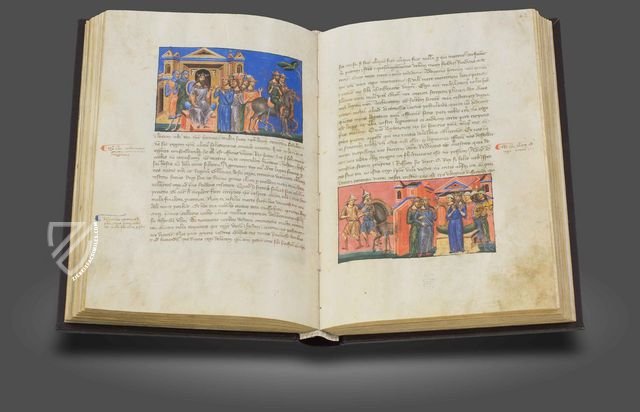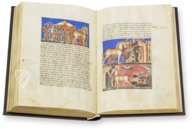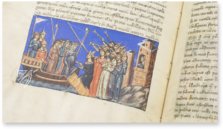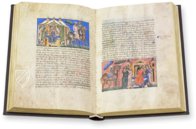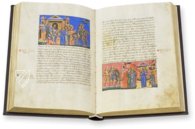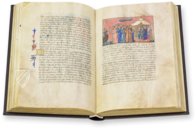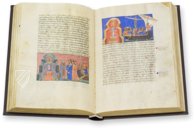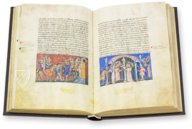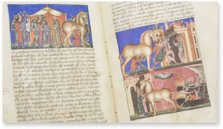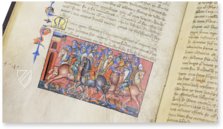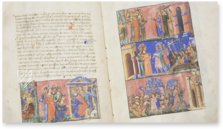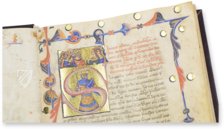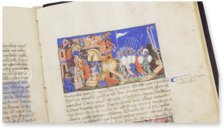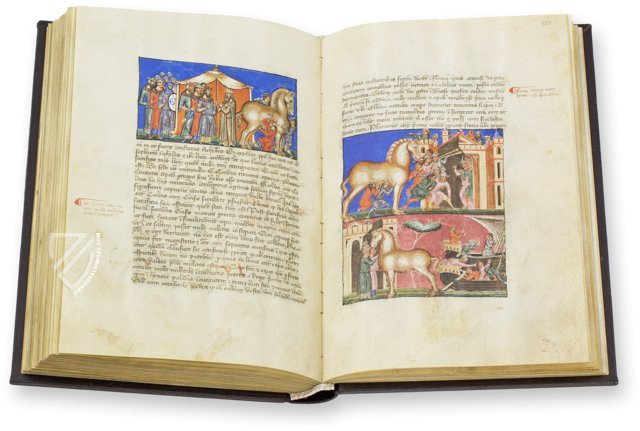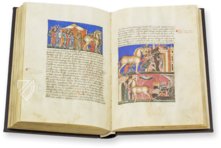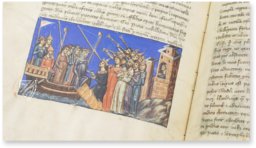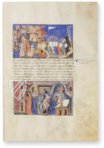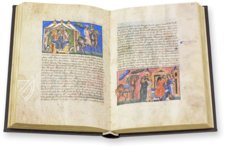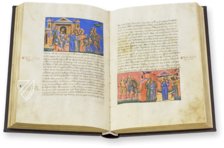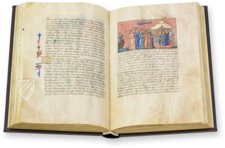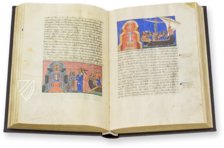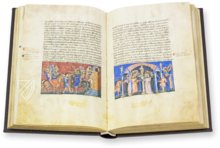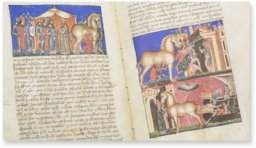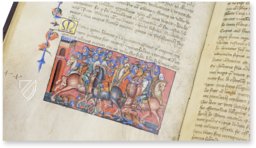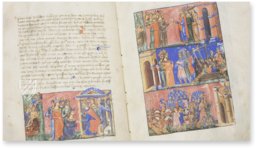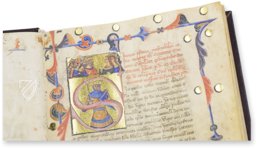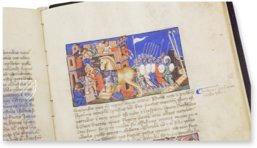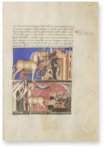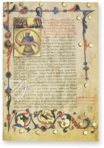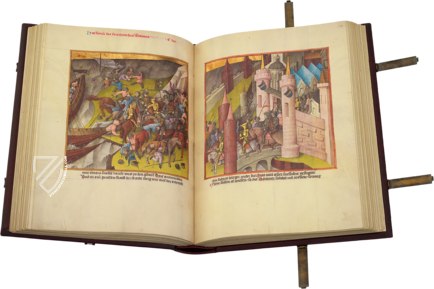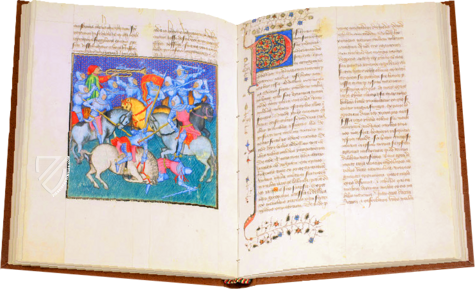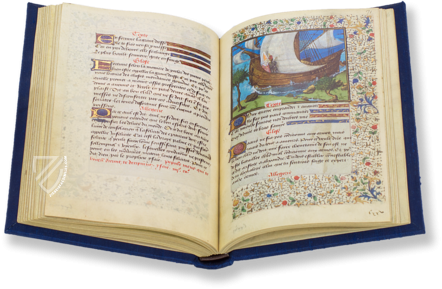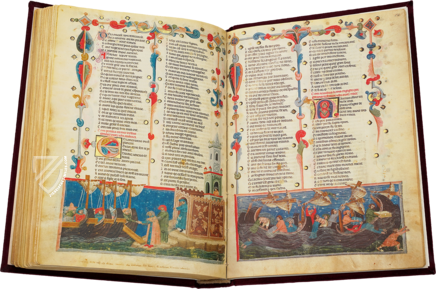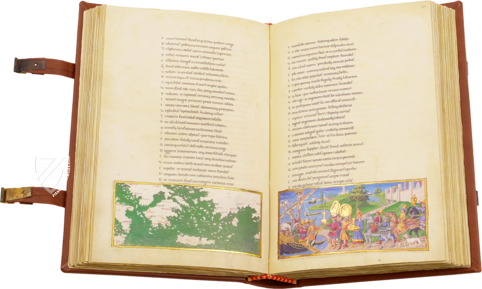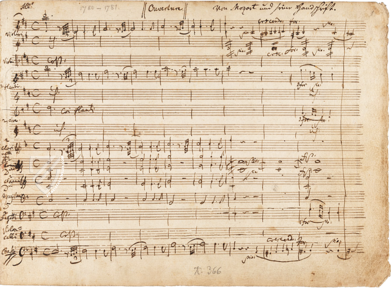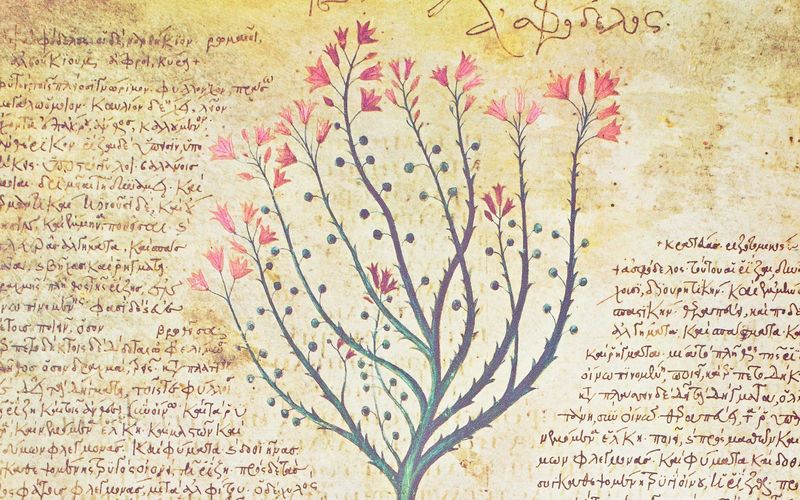History of the City of Troy
(3,000€ - 7,000€)
The medieval codex, which is preserved today in the Spanish National Library in Madrid under the shelf mark MS 17805, contains one of the most impressive and beautiful illuminated histories of the Trojan War. Guido delle Colonne (ca. 1210–1287), an Italian jurist, poet, and historian from the poetic circles of the court of Emperor Frederick II and his son Manfred, is considered to be the author of this Latin prose narrative. The copy in MS 17805 is written in black ink throughout, with the scribe using red only for the introductory incipit. Elaborate, historiated initials of raised, embossed gold surrounded by floral vines structure the text while colorful and richly detailed miniatures provide pictorial complements to the events described. The manuscript is believed to have originated in Venice ca. 1340–50 and may have come to Spain in the 16th century during the Italian Wars. The Trojan theme has been treated many times since antiquity and inspired many works (e.g. Virgil, Dictys and Dares, etc.) but only in MS 17805, however, are there descriptions of customs, everyday pleasures, and other features of life in the city before its fall. Thus, the Historia Civitatis Troiane is not only unique in content, but also one of the most beautiful and artistic books of the Trojan myth.
Historia Civitatis Troiane
Among the intellectual movements to gain steam during the Renaissance was the fascination with myths and histories from antiquity. Few tales have enjoyed such popularity throughout the centuries as that of the Trojan War. Love, passion, rivalries, betrayal, war, and doomed heroes – the tale has it all and was as attractive to medieval audiences as it continues to be for modern ones. One specimen is unique from the rest, because while all tell of the city’s fall, only one details daily life in Troy before its destruction: MS 17805 of the Spanish National Library, also known as the Historia Civitatis Troiane. Written in Latin by the famous Italian lawyer, poet, and historian Guido delle Colonne, the text is recorded in red and black ink, and is illustrated by brightly colored miniatures.
A Gem of the Early Renaissance
Colonne’s work was turned into a luxury manuscript in a Venetian atelier ca. 1340–1350, where it was adorned with 93 miniatures as rich in color as they are in detail, initials illuminated with burnished gold, and even some vegetal decoration in the margins of the text. Although there are other manuscripts with the story of the Fall of Troy, MS 17805 stands above the rest because it is the only one detailing the customs, traditions, leisure activities, etc. of the city. Although the identities of the work’s patron and the masters responsible for it continue to remain a mystery, the illumination was clearly influenced by Paolo Veneciano. This is an outstanding and unique specimen of the early Venetian Renaissance.
Mysterious Journey from Italy to Spain
Buchtel’s famous study of the manuscript has shed some light on the manuscript’s provenance and turbulent history. Although it is not known for certain, it is speculated that the manuscript made its way to Spain during the Italian Wars of the 16th century, when the major powers of Western Europe vied for control of the rich peninsula. He asserts that it was once owned by Alvar Gómez de Castro, and an anagram indicates that it also belonged to the Marqués de Navas. The manuscript was purchased by the Spanish National Library in 1899 as part of the collection of Pascual de Gayangos.
Codicology
- Alternative Titles
- Die Geschichte der Stadt Troja
Historia Civitatis Troianae - Size / Format
- 294 pages / 28.5 × 19.0 cm
- Origin
- Italy
- Date
- 1340–1350
- Epochs
- Style
- Language
- Script
- Littera bastarda
- Illustrations
- 93 ornate miniatures of different sizes, various golden initials with colorful scroll extenders, and a richly illuminated incipit page with a large historiated initial and opulent border
- Content
- Narration about the destruction of Troy by the Greeks
- Artist / School
- Influenced by Paolo Veneziano
- Previous Owners
- Alvar Gómez de Castro
Marqués de Navas
History of the City of Troy
Historiated “S” Initial
Appearing on the first text page of this wonderful specimen of Guido delle Colonne’s famous Trojan epic, this “S” initial shows a warrior king crowned and armed below a crowd of noble lords and ladies. The burnished gold leaf background shines beautifully and immediately attracts the eye of the beholder. This manuscript is distinguished for its depictions of medieval life, and the artist begins doing so even before the reader lays their eyes on the first miniature.
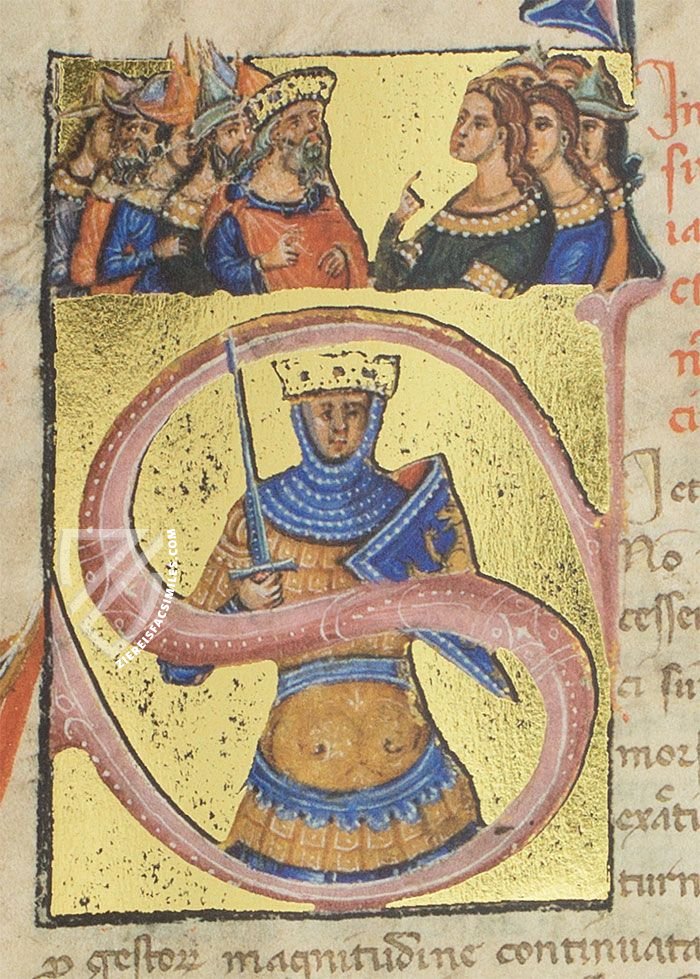
History of the City of Troy
The Assault on Troy
As the Trojans slept, Odysseus and his thirty Achaeans emerged from their great horse, killing the guards and opening the city’s gates. This famous act of subterfuge ended the war and resulted in the destruction of Troy. The events are presented here in two miniatures, fine specimens of Venetian illumination that are richly colored and detailed in equal measure.
The assault is launched from the Trojan Horse in the upper register and the army of the Greeks, which had pretended to withdraw by sailing out of sight, has returned, disembarked, and waits to rush in the gates. Below, King Priam is shown kneeling before the altar of Zeus in the palace courtyard just before he is killed by Neoptolemus, son of the famous warrior Achilles.

#1 Historia Civitatis Troianae
Language: Spanish
(3,000€ - 7,000€)
- Treatises / Secular Books
- Apocalypses / Beatus
- Astronomy / Astrology
- Bestiaries
- Bibles / Gospels
- Chronicles / History / Law
- Geography / Maps
- Saints' Lives
- Islam / Oriental
- Judaism / Hebrew
- Single Leaf Collections
- Leonardo da Vinci
- Literature / Poetry
- Liturgical Manuscripts
- Medicine / Botany / Alchemy
- Music
- Mythology / Prophecies
- Psalters
- Other Religious Books
- Games / Hunting
- Private Devotion Books
- Other Genres
- Afghanistan
- Armenia
- Austria
- Belgium
- Belize
- Bosnia and Herzegovina
- China
- Colombia
- Costa Rica
- Croatia
- Cyprus
- Czech Republic
- Denmark
- Egypt
- El Salvador
- Ethiopia
- France
- Germany
- Greece
- Guatemala
- Honduras
- Hungary
- India
- Iran
- Iraq
- Israel
- Italy
- Japan
- Jordan
- Kazakhstan
- Kyrgyzstan
- Lebanon
- Liechtenstein
- Luxembourg
- Mexico
- Morocco
- Netherlands
- Palestine
- Panama
- Peru
- Poland
- Portugal
- Romania
- Russia
- Serbia
- Spain
- Sri Lanka
- Sweden
- Switzerland
- Syria
- Tajikistan
- Turkey
- Turkmenistan
- Ukraine
- United Kingdom
- United States
- Uzbekistan
- Vatican City
- A. Oosthoek, van Holkema & Warendorf
- Aboca Museum
- Ajuntament de Valencia
- Akademie Verlag
- Akademische Druck- u. Verlagsanstalt (ADEVA)
- Aldo Ausilio Editore - Bottega d’Erasmo
- Alecto Historical Editions
- Alkuin Verlag
- Almqvist & Wiksell
- Amilcare Pizzi
- Andreas & Andreas Verlagsbuchhandlung
- Archa 90
- Archiv Verlag
- Archivi Edizioni
- Arnold Verlag
- ARS
- Ars Magna
- ArtCodex
- AyN Ediciones
- Azimuth Editions
- Badenia Verlag
- Bärenreiter-Verlag
- Belser Verlag
- Belser Verlag / WK Wertkontor
- Benziger Verlag
- Bernardinum Wydawnictwo
- BiblioGemma
- Biblioteca Apostolica Vaticana (Vaticanstadt, Vaticanstadt)
- Bibliotheca Palatina Faksimile Verlag
- Bibliotheca Rara
- Boydell & Brewer
- Bramante Edizioni
- Bredius Genootschap
- Brepols Publishers
- British Library
- C. Weckesser
- Caixa Catalunya
- Canesi
- CAPSA, Ars Scriptoria
- Caratzas Brothers, Publishers
- Carus Verlag
- Casamassima Libri
- Centrum Cartographie Verlag GmbH
- Chavane Verlag
- Christian Brandstätter Verlag
- Circulo Cientifico
- Club Bibliófilo Versol
- Club du Livre
- CM Editores
- Collegium Graphicum
- Collezione Apocrifa Da Vinci
- Comissão Nacional para as Comemorações dos Descobrimentos Portugueses
- Coron Verlag
- Corvina
- CTHS
- D. S. Brewer
- Damon
- De Agostini/UTET
- De Nederlandsche Boekhandel
- De Schutter
- Deuschle & Stemmle
- Deutscher Verlag für Kunstwissenschaft
- DIAMM
- Droz
- E. Schreiber Graphische Kunstanstalten
- Ediciones Boreal
- Ediciones Grial
- Ediclube
- Edições Inapa
- Edilan
- Editalia
- Edition Deuschle
- Edition Georg Popp
- Edition Leipzig
- Edition Libri Illustri
- Editiones Reales Sitios S. L.
- Éditions de l'Oiseau Lyre
- Editions Medicina Rara
- Editorial Casariego
- Editorial Mintzoa
- Editrice Antenore
- Editrice Velar
- Edizioni Edison
- Egeria, S.L.
- Eikon Editores
- Electa
- Emery Walker Limited
- Enciclopèdia Catalana
- Eos-Verlag
- Ephesus Publishing
- Ernst Battenberg
- Eugrammia Press
- Extraordinary Editions
- Fackelverlag
- Facsimila Art & Edition
- Facsimile Editions Ltd.
- Facsimilia Art & Edition Ebert KG
- Faksimile Verlag
- Feuermann Verlag
- Folger Shakespeare Library
- Franco Cosimo Panini Editore
- Friedrich Wittig Verlag
- Fundación Hullera Vasco-Leonesa
- G. Braziller
- Gabriele Mazzotta Editore
- Gebr. Mann Verlag
- Gesellschaft für graphische Industrie
- Getty Research Institute
- Giovanni Domenico de Rossi
- Giunti Editore
- Graffiti
- Grafica European Center of Fine Arts
- Guido Pressler
- Guillermo Blazquez
- Gustav Kiepenheuer
- H. N. Abrams
- Harrassowitz
- Harvard University Press
- Helikon
- Hendrickson Publishers
- Henning Oppermann
- Herder Verlag
- Hes & De Graaf Publishers
- Hoepli
- Holbein-Verlag
- Houghton Library
- Hugo Schmidt Verlag
- Idion Verlag
- Il Bulino, edizioni d'arte
- ILte
- Imago
- Insel Verlag
- Insel-Verlag Anton Kippenberger
- Instituto de Estudios Altoaragoneses
- Instituto Nacional de Antropología e Historia
- Introligatornia Budnik Jerzy
- Istituto dell'Enciclopedia Italiana - Treccani
- Istituto Ellenico di Studi Bizantini e Postbizantini
- Istituto Geografico De Agostini
- Istituto Poligrafico e Zecca dello Stato
- Italarte Art Establishments
- Jan Thorbecke Verlag
- Johnson Reprint Corporation
- Josef Stocker
- Josef Stocker-Schmid
- Jugoslavija
- Karl W. Hiersemann
- Kasper Straube
- Kaydeda Ediciones
- Kindler Verlag / Coron Verlag
- Kodansha International Ltd.
- Konrad Kölbl Verlag
- Kurt Wolff Verlag
- La Liberia dello Stato
- La Linea Editrice
- La Meta Editore
- Lambert Schneider
- Landeskreditbank Baden-Württemberg
- Leo S. Olschki
- Les Incunables
- Liber Artis
- Library of Congress
- Libreria Musicale Italiana
- Lichtdruck
- Lito Immagine Editore
- Lumen Artis
- Lund Humphries
- M. Moleiro Editor
- Maison des Sciences de l'homme et de la société de Poitiers
- Manuscriptum
- Martinus Nijhoff
- Maruzen-Yushodo Co. Ltd.
- MASA
- Massada Publishers
- McGraw-Hill
- Metropolitan Museum of Art
- Militos
- Millennium Liber
- Müller & Schindler
- Nahar - Stavit
- Nahar and Steimatzky
- National Library of Wales
- Neri Pozza
- Nova Charta
- Oceanum Verlag
- Odeon
- Orbis Mediaevalis
- Orbis Pictus
- Österreichische Staatsdruckerei
- Oxford University Press
- Pageant Books
- Parzellers Buchverlag
- Patrimonio Ediciones
- Pattloch Verlag
- PIAF
- Pieper Verlag
- Plon-Nourrit et cie
- Poligrafiche Bolis
- Presses Universitaires de Strasbourg
- Prestel Verlag
- Princeton University Press
- Prisma Verlag
- Priuli & Verlucca, editori
- Pro Sport Verlag
- Propyläen Verlag
- Pytheas Books
- Quaternio Verlag Luzern
- Reales Sitios
- Recht-Verlag
- Reichert Verlag
- Reichsdruckerei
- Reprint Verlag
- Riehn & Reusch
- Roberto Vattori Editore
- Rosenkilde and Bagger
- Roxburghe Club
- Salerno Editrice
- Saltellus Press
- Sandoz
- Sarajevo Svjetlost
- Schöck ArtPrint Kft.
- Schulsinger Brothers
- Scolar Press
- Scrinium
- Scripta Maneant
- Scriptorium
- Shazar
- Siloé, arte y bibliofilia
- SISMEL - Edizioni del Galluzzo
- Sociedad Mexicana de Antropología
- Société des Bibliophiles & Iconophiles de Belgique
- Soncin Publishing
- Sorli Ediciones
- Stainer and Bell
- Studer
- Styria Verlag
- Sumptibus Pragopress
- Szegedi Tudomànyegyetem
- Taberna Libraria
- Tarshish Books
- Taschen
- Tempus Libri
- Testimonio Compañía Editorial
- Thames and Hudson
- The Clear Vue Publishing Partnership Limited
- The Facsimile Codex
- The Folio Society
- The Marquess of Normanby
- The Richard III and Yorkist History Trust
- Tip.Le.Co
- TouchArt
- TREC Publishing House
- TRI Publishing Co.
- Trident Editore
- Tuliba Collection
- Typis Regiae Officinae Polygraphicae
- Union Verlag Berlin
- Universidad de Granada
- University of California Press
- University of Chicago Press
- Urs Graf
- Vallecchi
- Van Wijnen
- VCH, Acta Humaniora
- VDI Verlag
- VEB Deutscher Verlag für Musik
- Verlag Anton Pustet / Andreas Verlag
- Verlag Bibliophile Drucke Josef Stocker
- Verlag der Münchner Drucke
- Verlag für Regionalgeschichte
- Verlag Styria
- Vicent Garcia Editores
- W. Turnowski Ltd.
- W. Turnowsky
- Waanders Printers
- Wiener Mechitharisten-Congregation (Wien, Österreich)
- Wissenschaftliche Buchgesellschaft
- Wissenschaftliche Verlagsgesellschaft
- Wydawnictwo Dolnoslaskie
- Xuntanza Editorial
- Zakład Narodowy
- Zollikofer AG

